Related Research Articles

The Sopwith Tabloid and Sopwith Schneider were British biplanes, originally designed as sports aircraft and later adapted for military use. They were among the first types to be built by the Sopwith Aviation Company. The "Tabloid", so named because of its small size, caused a sensation when it made its first public appearance.

The Vickers F.B.19 was a British single-seat fighting scout of the First World War, developed from the Barnwell Bullet prototype, and sometimes known as the Vickers Bullet. It served with the Royal Flying Corps and the Imperial Russian Air Service, which subsequently led to the Red Air Force adopting it during the Russian Civil War.

The Kawanishi E7K was a Japanese 1930s three-seat reconnaissance seaplane. It was allocated the reporting name Alf by the Allies of World War II.

The Avro Type 584 Avocet was a British single-engined naval fighter prototype, designed and built by Avro. While the Avocet was not built in numbers, one of the prototypes was used as a seaplane trainer for the Royal Air Force's (RAF) High Speed Flight.
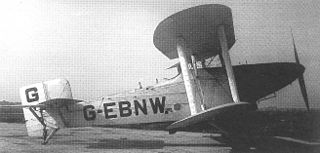
The Avro 571 Buffalo was a prototype British carrier-based torpedo bomber biplane, designed and built by Avro in the 1920s. It was not selected for service, the Blackburn Ripon being ordered instead.
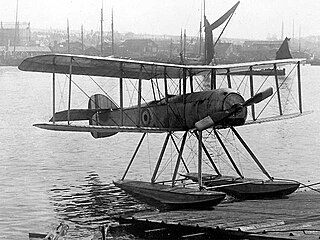
The Wight Baby was a British single-seat seaplane fighter produced by John Samuel White & Company Limited. Only three prototype aircraft were built.
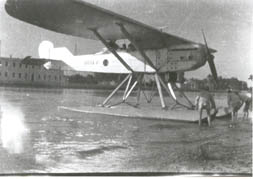
The Breda A.7 was a reconnaissance aircraft developed in Italy for use by the Regia Aeronautica in 1929. It was a braced parasol monoplane of conventional configuration with tailskid undercarriage. The pilot and observer sat in tandem, open cockpits. A single prototype of a long-range example, originally designated A.7 Raid and later A.16 was also constructed, but the air force showed no interest in it.
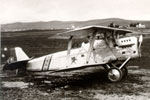
The Vickers Valparaiso was a British light bomber biplane of the 1920s. It was designed by Vickers as a development of its Vixen for export, being sold to Portugal and Chile.

The Supermarine Swan was a 1920s British experimental amphibian aircraft built by Supermarine at Woolston. Only one was built and it was used for a passenger service between England and France.
The Supermarine Commercial Amphibian was a British passenger-carrying flying boat designed by Reginald Mitchell and built by the Supermarine Aviation Works.
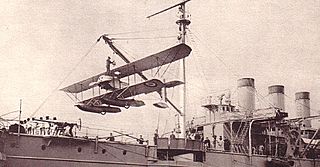
The Caudron J Marine was an amphibious, two-seat, biplane equipped with floats and wheels, similar to the earlier Caudron J floatplane.
The Vickers E.F.B.8 was a prototype British twin-engined fighter of the First World War. It was abandoned after only one aircraft was built, single-engined fighters being considered to have superior manoeuvrability.
The Sopwith Gunbus was a British fighter aircraft of the First World War. It was a single-engined pusher biplane based on a floatplane built by Sopwith before the war for Greece. Small numbers were built and used by the British Royal Naval Air Service, mainly as a trainer.
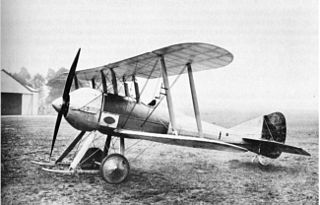
The Royal Aircraft Factory S.E.2 was an early British single-seat scout aircraft. Designed and built at the Royal Aircraft Factory in 1912–13 as the B.S.1, the prototype was rebuilt several times before serving with the Royal Flying Corps over the Western Front in the early months of the First World War.

The Short S.41 was a British single-engined biplane built for the Royal Navy in 1912. Capable of being operated either on wheels or floats, it was successful enough for a further two similar aircraft to be built, with the type remaining in use until the early years of the First World War.

The Vickers F.B.16 was a British single-seat fighter aircraft of the First World War. It was originally designed to be powered by an experimental radial engine, development of which was abandoned. When re-engined with more powerful and reliable water-cooled V-8 engines, the F.B.16 demonstrated good performance, but only a few prototypes were built, the type not entering service.
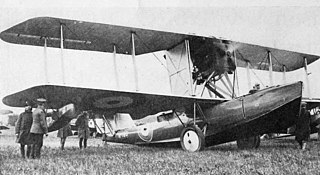
The Supermarine Sheldrake was a British amphibian biplane flying boat developed by Supermarine from the Supermarine Seagull with a revised hull. It was powered by a Napier Lion engine mounted between the wings driving a four-bladed propeller. Only one Sheldrake, serial number N180, was built.

The Short S.81 was an experimental British gun-carrying pusher biplane seaplane, ordered from Short Brothers by the British Admiralty in 1913 for use by the Royal Naval Air Service.
RWD 22 was a Polish twin-engine torpedo bomber and naval reconnaissance floatplane design. Developed by Leszek Dulęba and Andrzej Anczutin of Doświadczalne Warsztaty Lotnicze in 1939, the project was to be developed under the brand of the RWD design bureau. The outbreak of World War II interrupted the design and it never left the planning stage.
The Vickers Tractor Scout was a British scout aircraft built by Vickers in the early 1910s.
References
- ↑ Andrews, C.F and Morgan, E.B., 1988. Vickers Aircraft since 1908. London: Putnam. ISBN 0-85177-815-1.
- ↑ Goodall, Michael H.; Tagg, Albert E. (2001). British Aircraft before the Great War. Atglen, PA, USA: Schiffer Publishing Ltd. ISBN 0-7643-1207-3.
- ↑ Lewis, P (1962). British Aircraft 1809-1914. London: Putnam.